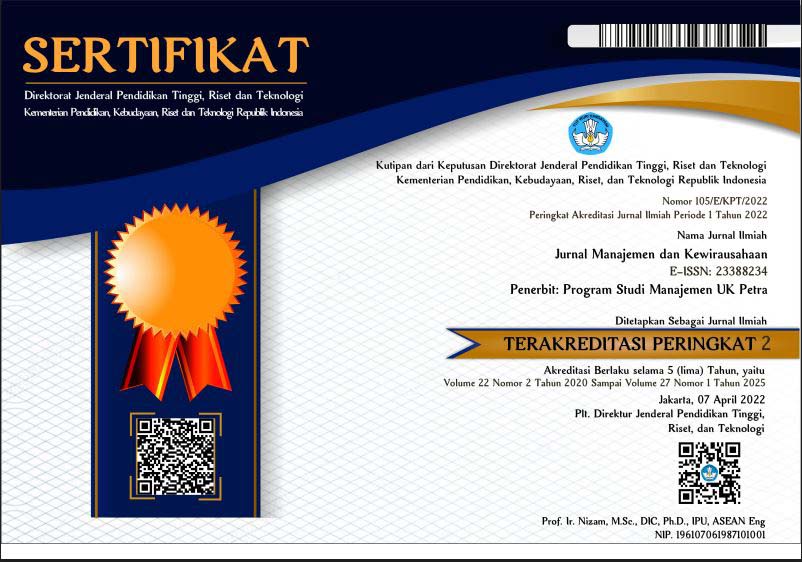TECHNOLOGY LEADERSHIP IN INDONESIAN JUNIOR HIGH SCHOOLS DURING THE POST-COVID ERA: A CASE STUDY OF SPIRITUAL DIMENSIONS
DOI:
https://doi.org/10.9744/jmk.27.1.53-80Keywords:
Leading school, New normal, Online learning, Spiritual, Technology leadershipAbstract
COVID-19 in Indonesia necessitated a shift from traditional face-to-face learning to technology-based distance learning. This transition also redefined the role of school principal who must lead change and work in new ways. This study aims to explore the new role of the principal as a technology leader and develop a technology leadership model in learning in the new normal era. Employing a qualitative approach with a single case study method, the study involved 20 participants, including 5 principals, 5 vice principals, 5 IT coordinators, and 5 subject teachers from five public junior high schools (SMP Negeri) in Surabaya, Indonesia.. The findings study show that school principal has a key role in keeping the school functioning well in the new normal era. This findings highlight the latest model of technology leadership in education by developing 5 dimensions of technology leadership from NETS-EL 2018 into 6 dimensions. The spiritual dimension makes technology leaders and teachers are more effective in leading schools during and after COVID-19. These findings specifically contribute to the development of a technology leadership framework and generally complement existing leadership theories.
References
Ade Heryana. (2024). Teori kepemimpinan : trait theory , behavioral theory , dan situational teori kepemimpinan : trait theory , behavioral theory , dan situational leadership. September. https://doi.org/10.13140/RG.2.2.33484.22406
Ali, M., Usman, M., Aziz, S., & Rofcanin, Y. (2021). Undermining alienative commitment through spiritual leadership: a moderated mediation model of social capital and political skill. Journal of Asian Business and Economic Studies.
Al Saidi, A. M. O., Nur, F. A., Al-Mandhari, A. S., El Rabbat, M., Hafeez, A., & Abubakar, A. (2020). Decisive leadership is a necessity in the COVID-19 response. The Lancet, 396(10247), 295–298.
Anderson, R. E., & Dexter, S. (2005). School technology leadership: An empirical investigation of prevalence and effect. Educational Administration Quarterly, 41(1), 49–82.
Anderson, R. E., & Dexter, S. L. (2000). School technology leadership: incidence and impact author:
Avolio, B. J., Sosik, J. J., Kahai, S. S., & Baker, B. (2014). E-leadership: Re-examining transformations in leadership source and transmission. The Leadership Quarterly, 25(1), 105–131.
Aydin, C. C., & Tirkes, G. (2010). Open source learning management systems in e-learning and moodle. IEEE EDUCON Education Engineering.
B, M. R. R., Lesmana, I., Dhia, H., & Safitri, A. (2023). Proceedings of the International Conference on Educational Management and Technology (ICEMT 2022). In Proceedings of the International Conference on Educational Management and Technology (ICEMT 2022). Atlantis Press SARL. https://doi.org/10.2991/978-2-494069-95-4
Bogdandy, B., Tamas, J., & Toth, Z. (2020). Digital transformation in education during COVID-19: A case study. 2020 11th IEEE International Conference on Cognitive Infocommunications (CoginfoCom), 173–178. IEEE.
Cascio, W. F., & Shurygailo, S. (2003). E-leadership and virtual teams. Organizational Dynamics, 31(4), 362–376. https://doi.org/10.1016/S0090-2616(02)00130-4
Chen, Y.-H. (2007). Principals’ distributed leadership behaviors and their impact on student achieve-ment in selected elementary schools in Texas. Texas A&M University.
Chua, Y. P., & Chua, Y. P. (2017). How are e-leadership practices in implementing a school virtual learning environment enhanced? A grounded model study. Computers & Education, 109, 109–121.
Cox, A. E., Smith, A. L., & Williams, L. (2008). Change in physical education motivation and physical activity behavior during middle school. Journal of Adolescent Health, 43(5), 506–513. https://doi.org/10.1016/j.jadohealth.2008.04.020
Creswell, J. W. (2012). Research design. In SAGE.
Dexter, S. (2011). School technology leadership: Artifacts in systems of practice. Journal of School Leadership, 21(2), 166–189.
Domina, T., Renzulli, L., Murray, B., Garza, A. N., & Perez, L. (2021). Remote or removed: predicting successful engagement with online learning during COVID-19. Socius, 7. https://doi.org/10.1177/2378023120988200
Emelyanova, N., & Voronina, E. (2014). Introducing a learning management system at a russian university: Students’ and teachers’ perceptions. International Review of Research in Open and Distance Learning, 15(1), 272–289. https://doi.org/10.19173/irrodl.v15i1.1701
Fry, L. (2016). Spiritual leadership. In Global encyclopedia of public administration, public policy, and governance. https://doi.org/10.1007/978-3-319-31816-5_2353-1
Fry, L. W. (2003). Toward a theory of spiritual leadership. The Leadership Quarterly, 14(6), 693–727.
Fry, L. W., Vitucci, S., & Cedillo, M. (2005). Spiritual leadership and army transformation: Theory, measurement, and establishing a baseline. The Leadership Quarterly, 16(5), 835–862.
Fung Kee Fung, M., Walker, M., Fung Kee Fung, K., Temple, L., Lajoie, F., Bellemare, G., & Bryson, S. C. P. (2000). An internet-based learning portfolio in resident education: The KOALA(TM) multicentre programme. Medical Education, 34(6), 474–479. https://doi.org/10.1046/j.1365-2923.2000.00571.x
Flanagan, L., & Jacobsen, M. (2003). Technology leadership for the twenty-first century principal. Journal of Educational Administration, 41(2), 124–142. https://doi.org/10.1108/09578230310464648
Green, A. E., Miller, E. A., & Aarons, G. A. (2013). Transformational leadership moderates the relationship between emotional exhaustion and turnover intention among community mental health providers. Community Mental Health Journal, 49(4), 373–379. https://doi.org/10.1007/s10597-011-9463-0
Gençer, M. S., & Samur, Y. (2016). Leadership styles and technology: Leadership competency level of educational leaders. Procedia-Social and Behavioral Sciences, 229, 226–233.
Grady, M. L. (2011). Leading the technology-powered school. Corwin Press.
Gurr, D. (2004). ICT, Leadership in education and e-leadership. International Journal of Phytoreme-diation, 25(1), 113–124. https://doi.org/10.1080/0159630042000178518
Hadriana, Mahdum, Isjoni, Futra, D., & Primahardani, I. (2021). Online learning management in the era of Covid-19 pandemic at junior high schools in Indonesia. Journal of Information Technology Education: Research, 20, 351–383. https://doi.org/10.28945/4819
Hambley, L. A., O’Neill, T. A., & Kline, T. J. B. (2009). Virtual team leadership: Perspectives from the field. Virtual Team Leadership and Collaborative Engineering Advancements: Contemporary Issues and Implications, 3(1), 84–104. https://doi.org/10.4018/978-1-60566-110-0.ch007
Hamzah, H. N., Khalid, M., & Wahab, J. A. (2021). The effects of principals’ digital leadership on teachers’ digital teaching during the covid-19 pandemic in malaysia. Journal of Education and E-Learning Research, 8(2), 216–221. https://doi.org/10.20448/journal.509.2021.82.216.221
Harris, A. (2020). COVID-19 – school leadership in crisis? Journal of Professional Capital and Community, 5(3–4), 321–326. https://doi.org/10.1108/JPCC-06-2020-0045
ISTE, I. S. for T. in E. (2009). Standards for administrators. Retrieved from http://www.iste.org/standards/iste-standards/standards-foradministrators
ISTE, I. S. for T. in E. (2018). Iste standards: education leaders. Retrieved November 12, 2024, from https://www.iste.org/standards/iste-standards-for-education-leaders
Jameson, J. (2013). e‐L eadership in higher education: T he fifth “age” of educational technology research. British Journal of Educational Technology, 44(6), 889–915.
Karakose, T. (2021). The impact of the COVID-19 epidemic on higher education: Opportunities and implications for policy and practice. Educational Process: International Journal, 10(1), 7–12. https://doi.org/10.22521/EDUPIJ.2021.101.1
Kearsley, G., & Lynch, W. (1994). Educational Technology: Leadership Perspectives. Educational Technology.
Kementerian Sosial Republik Indonesia. (2020). “New normal”, tahukah anda? Retrieved July 10, 2022, from Kementerian Sosial Republik Indonesia website: https://kemensos.go.id/new-normal-tahukah-anda
Leithwood, K., Harris, A., & Hopkins, D. (2020). Seven strong claims about successful school leadership revisited. School Leadership and Management, 40(1), 5–22. https://doi.org/10.1080/13632434.2019.1596077
McLeod, S., Bathon, J. M., & Richardson, J. W. (2011). Studies of technology tool usage are not enough: A response to the articles in this special issue. Journal of Research on Leadership Education, 6(5), 288–297.
Mrazek, R., Hollingsworth, M., & Steed, M. B. (2005). Scaling the Digital Leadership Divide. Business.
Mustapha, A. T., & Kurt, M. (2021). The growth and challenges of virtual learning of English language in nigeria in times of COVID-19 Pandemic. International Online Journal of Education and Teaching, 8(3), 1312–1323.
Pelgrum, W. J., & Plomp, T. (1993). The use of computers in education in 18 countries. Studies in Educational Evaluation, 19(2), 101–125. https://doi.org/10.1016/0191-491X(93)90002-9
Pokhrel, S., & Chhetri, R. (2021). A literature review on impact of COVID-19 pandemic on teaching and learning. Higher Education for the Future, 8(1), 133–141. https://doi.org/10.1177/2347631120983481
Rateno, C. J. (2019). Ohio principals? perceptions on their technology literacy. Youngstown State University.
Richardson, J. W., & McLeod, S. (2011). Technology leadership in Native American schools. Journal of Research in Rural Education (Online), 26(7), 1.
Salas‐Vallina, A., Ferrer‐Franco, A., & Herrera, J. (2020). Fostering the healthcare workforce during the COVID‐19 pandemic: Shared leadership, social capital, and contagion among health professionals. The International Journal of Health Planning and Management, 35(6), 1606–1610.
Schleicher, A. (2018). Educating learners for their future, not our past1. ECNU Review of Education, 1(1), 58–75. https://doi.org/10.30926/ecnuroe2018010104
Senge, P. M. (1990). The fifth discipline: the art and practice of the learning organization. In Choice Reviews Online (Vol. 44, Issue 05). Currency Doubleday. https://doi.org/10.5860/choice.44-2797
Shufutinsky, A., DePorres, D., Long, B., & Sibel, J. R. (2020). Shock leadership development for the modern era of pandemic management and preparedness. International Journal of Organizational Innovation, 13(1).
Sincar, M. (2013). Challenges school principals facing in tech leadership. 6th International Computer and Instructional Technologies Symposium, Gaziantep, Turkey, 13(2), 1273–1284.
Stegall, P., & Ed, D. (1998). The principal key to technology implementation presentation at the nationsal Catholic education association convention tr.
Sultana, U. S., Tarofder, A. K., Darun, M. R., Haque, A., & Sharief, S. R. (2020). Authentic leadership effect on pharmacists job stress and satisfaction during COVID-19 pandemic: Malaysian perspective. Journal of Talent Development and Excellence, 12(3s), 1824–1841.
Sung, Y. T., Chang, K. E., & Liu, T. C. (2016). The effects of integrating mobile devices with teaching and learning on students’ learning performance: A meta-analysis and research synthesis. Computers and Education, 94, 252–275. https://doi.org/10.1016/j.compedu.2015.11.008
Suprapti, S., Asbari, M., Cahyono, Y., & Mufid, A. (2020). Leadership style, organizational culture and innovative behavior on public health center performance during Pandemic Covid-19. Journal of Industrial Engineering & Management Research, 1(2), 76–88.
Tan, S. C. (2010). School technology leadership: Lessons from empirical research. ASCILITE 2010 - The Australasian Society for Computers in Learning in Tertiary Education, December 2010, 896–906. https://doi.org/10.14742/apubs.2010.2001
Okunlola, J. O. (2024). Digital technology adoption and school leadership in the post-pandemic era: Insights from high school leaders. Interdisciplinary Journal of Education Research, 6, 1–14. https://doi.org/10.38140/ijer-2024.vol6.32
Van, N. T., Abbas, A. F., Abuhassna, H., Awae, F., & Dike, D. (2021). Digital readiness for social educators in health care and online learning during COVID-19 pandemic: a bibliometric analysis. International Journal of Interactive Mobile Technologies, 15(18), 104–115. https://doi.org/10.3991/ijim.v15i18.25529
Van Welsum, D., & Lanvin, B. (2012). Technology leadership skills: vision report, prepared for the EuropeanCommission.
Wicaksono, A., & Setyowati, L. (2022). Teacher's perspectives of online learning vs. offline leaning: a case study from West Java. KnE Social Sciences, 86-95.
Yee, D. L. (2000). Images of school principals’ information and communications technology leadership. Journal of Information Technology for Teacher Education, 9(3), 287–30.
Downloads
Published
How to Cite
Issue
Section
License
Copyright (c) 2025 Shinta Setia

This work is licensed under a Creative Commons Attribution 4.0 International License.
Authors who publish on this journal agree to the following terms:
- Authors retain copyright and grant the journal right of first publication with the work simultaneously licensed under a Creative Commons Attribution License that allows others to share the work with an acknowledgement of the work's authorship and initial publication in this journal.
- Authors are able to enter into separate, additional contractual arrangements for the non-exclusive distribution of the journal's published version of the work (e.g., post it to an institutional repository or publish it in a book), with an acknowledgement of its initial publication in this journal.
- Authors are permitted and encouraged to post their work online (e.g., in institutional repositories or on their website) prior to and during the submission process, as it can lead to productive exchanges, as well as earlier and greater citation of published work (See The Effect of Open Access).


















